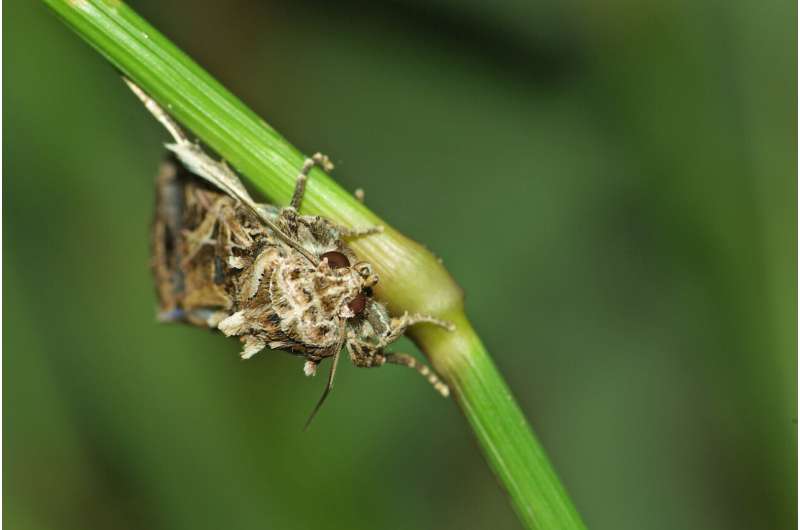This article has been reviewed according to Science X's editorial process and policies. Editors have highlighted the following attributes while ensuring the content's credibility:
fact-checked
peer-reviewed publication
proofread
Surprising role of female sex pheromone in crop pest points to new biocontrol possibilities

INRAE researchers have discovered that female pheromones play a remarkable role in the African cotton moth. In general, these pheromones trigger mate attraction, promoting encounters between males and females during reproductive periods. Astonishingly, the African cotton moth possesses a pheromonal compound whose modulatory effects exceed those of light itself, a discovery that can inform future biocontrol strategies. These results are published in Current Biology.
In animals, social interactions can have a pronounced influence on circadian rhythms, such as helping to regulate the timing of rest. For the circadian clock to function effectively, it must be entrained by local day-night cycles, a process that employs cues such as light and temperature.
Researchers at INRAE have been exploring how sociosexual interactions can modulate circadian rhythm. Elemental social interactions remain essential even in solitary animal species, such as the African cotton moth and Spodoptera littoralis. The latter is an agricultural pest whose caterpillars attack maize and legume crops. Adults live just 7 to 8 days, and thus, adult males devote themselves exclusively to mating.
While studying S. littoralis, researchers observed that the circadian rhythm of males changed in the presence of females. Males can perceive female pheromones even across very long distances. Thus, females can remotely modulate the circadian rhythm of males such that the sexes are in synchrony during periods of mating, which favors reproductive success.
In S. littoralis, the pheromone gland synthesizes diverse chemical compounds, but only one (Z,E)-9,11-tetradecadienyl acetate (i.e., Z9E11-14Ac) can attract males. When males are exposed to Z9E11-14Ac, their circadian rhythms are altered, even in broad daylight.
This result is the first of its kind: never before in a solitary animal species has a sociosexual interaction been shown to affect the circadian clock, let alone surpass light in its entrainment effects. The study's discovery paves the way for new research into circadian synchronization, including in mammals.
The black cutworm Agrotis ipsilon is a close relative of S. littoralis and exhibits a significant degree of niche overlap. Interestingly, while pheromones from A. ipsilon can modulate male circadian rhythm in S. littoralis, the two species do not mate.
The researchers are exploring how their findings can inform the development of biocontrol practices targeting S. littoralis. The idea is that since females do not respond strongly to their own pheromones, males could be exposed to pheromones in the morning (i.e., outside of the natural chemical communication window), which would modify their circadian rhythm for the day. As a result, the two sexes would be out of sync and less likely to meet and mate.
More information: Sagnik Ghosh et al, Pheromone-mediated command from the female to male clock induces and synchronizes circadian rhythms of the moth Spodoptera littoralis, Current Biology (2024). DOI: 10.1016/j.cub.2024.02.042
Journal information: Current Biology
Provided by INRAE - National Research Institute for Agriculture, Food and Environment




















